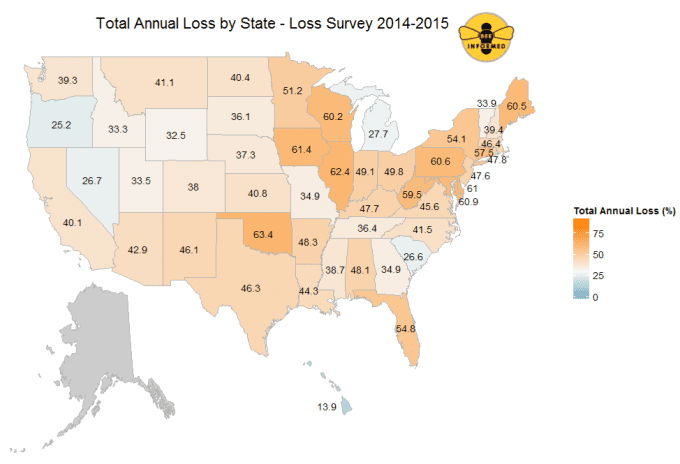Nathalie Steinhauer1, Karen Rennich1, Kathleen Lee2, Jeffery Pettis3, David R. Tarpy4, Juliana Rangel5, Dewey Caron6, Ramesh Sagili6, John A. Skinner7, Michael E. Wilson7, James T. Wilkes8, Keith S. Delaplane9, Robyn Rose10, Dennis vanEngelsdorp1
1 Department of Entomology, University of Maryland, College Park, MD 20742
2 Department of Entomology, University of Minnesota, St. Paul, MN 55108
3 United States Department of Agriculture, Agricultural Research Service, Beltsville, MD
4 Department of Entomology, North Carolina State University, Raleigh NC 27695
5 Department of Entomology, Texas A&M University, College Station, TX 77843
6 Department of Horticulture, Oregon State University, Corvallis, OR 97331
7 Department of Entomology and Plant Pathology, University of Tennessee, Knoxville, TN 37996
8 Department of Computer Science, Appalachian State University, Boone, NC 28608
9 Department of Entomology, University of Georgia, Athens, GA 30602
10 United States Department of Agriculture, Animal and Plant Health Inspection Service, Riverdale, MD
Corresponding Author: dvane@umd.edu
Note: This is a preliminary analysis. Sample sizes and estimates are likely to change. A more detailed final report is being prepared for publication in a peer-reviewed journal at a later date.
The Bee Informed Partnership (https://beeinformed.org), in collaboration with the Apiary Inspectors of America (AIA) and the United States Department of Agriculture (USDA), is releasing preliminary results for the ninth annual national survey of honey bee colony losses. For the 2014/2015 winter season, a preliminary 6,128 beekeepers in the United States provided valid responses. Collectively, these beekeepers managed 398,247 colonies in October 2014, representing about 14.5% of the country’s estimated 2.74 million managed honey bee colonies1.
About two-thirds of the respondents (67.2%) experienced winter colony loss rates greater than the average self-reported acceptable winter mortality rate of 18.7%. Preliminary results estimate that a total of 23.1% of the colonies managed in the Unites States were lost over the 2014/2015 winter. This would represent a decrease in losses of 0.6% compared to the previous 2013/2014 winter, which had reported a total loss estimated at 23.7%. This is the second year in a row the reported colony loss rate was notably lower than the 9-year average total loss of 28.7% (see Figure 1).

Beekeepers do not only lose colonies in the winter but also throughout the summer, sometimes at significant levels. To quantify this claim of non-winter colony mortality of surveyed beekeepers, we have included summer and annual colony losses since 2010/2011. In the summer of 2014 (April – October), colony losses surpassed winter losses at 27.4% (totalsummer loss). This compares to summer losses of 19.8% in 2013. Importantly, commercial beekeepers appear to consistently lose greater numbers of colonies over the summer months than over the winter months, whereas the opposite seems true for smaller-scale beekeepers. Responding beekeepers reported losing 42.1% of the total number of colonies managed over the last year (total annual loss, between April 2014 and April 2015). This represents the second highest annual loss recorded to date.
As in previous years, colony losses were not consistent across the country, with annual losses exceeding 60% in several states, while Hawaii reported the lowest total annual colony loss of ~14% (see Figure 2).

This survey was conducted by the Bee Informed Partnership, which receives a majority of its funding from the National Institute of Food and Agriculture, USDA (award number: 2011-67007-20017).
1 Based on NASS 2015 figures
2 Previous survey results found a total colony loss in the winters of 24% in the winter of 2013/2014, 30% in 2012/2013, 22% in 2011/2012, 30% in 2010/2011, 32% in 2009/2010, 29% in 2008/2009, 36% in 2007/2008, and 32% in 2006/2007 (see reference list).
- Lee, KV; Steinhauer, N; Rennich, K; Wilson, ME; Tarpy, DR; Caron, DM; Rose, R; Delaplane, KS; Baylis, K; Lengerich, EJ; Pettis, J; Skinner, JA; Wilkes, JT; Sagili, R; vanEngelsdorp, D; for the Bee Informed Partnership (2015) A national survey of managed honey bee 2013–2014 annual colony losses in the USA. Apidologie, 1–14. DOI:10.1007/s13592-015-0356-z
- Steinhauer, NA; Rennich, K; Wilson, ME; Caron, DM; Lengerich, EJ; Pettis, JS; Rose, R; Skinner, JA; Tarpy, DR; Wilkes, JT; vanEngelsdorp, D (2014) A national survey of managed honey bee 2012-2013 annual colony losses in the USA: results from the Bee Informed Partnership. Journal of Apicultural Research, 53(1): 1–18. DOI:10.3896/IBRA.1.53.1.01
- Spleen, AM; Lengerich, EJ; Rennich, K; Caron, D; Rose, R; Pettis, JS; Henson, M; Wilkes, JT; Wilson, M; Stitzinger, J; Lee, K; Andree, M; Snyder, R; vanEngelsdorp, D (2013) A national survey of managed honey bee 2011-12 winter colony losses in the United States: results from the Bee Informed Partnership. Journal of Apicultural Research, 52(2): 44–53. DOI:10.3896/IBRA.1.52.2.07
- vanEngelsdorp, D; Caron, D; Hayes, J; Underwood, R; Henson, M; Rennich, K; Spleen, A; Andree, M; Snyder, R; Lee, K; Roccasecca, K; Wilson, M; Wilkes, J; Lengerich, E; Pettis, J (2012) A national survey of managed honey bee 2010-11 winter colony losses in the USA: results from the Bee Informed Partnership. Journal of Apicultural Research, 51(1): 115–124. DOI:10.3896/IBRA.1.51.1.14
- vanEngelsdorp, D; Hayes, J; Underwood, RM; Caron, D; Pettis, J (2011) A survey of managed honey bee colony losses in the USA, fall 2009 to winter 2010. Journal of Apicultural Research, 50(1): 1–10. DOI:10.3896/IBRA.1.50.1.01
- vanEngelsdorp, D; Hayes, J; Underwood, RM; Pettis, JS (2010) A survey of honey bee colony losses in the United States, fall 2008 to spring 2009. Journal of Apicultural Research, 49(1): 7–14. DOI:10.3896/IBRA.1.49.1.03
- vanEngelsdorp, D; Hayes, J; Underwood, RM; Pettis, J (2008) A Survey of Honey Bee Colony Losses in the U.S., Fall 2007 to Spring 2008. PLoS ONE, 3(12). DOI:10.1371/journal.pone.0004071
- vanEngelsdorp, D; Underwood, R; Caron, D; Hayes, J (2007) An estimate of managed colony losses in the winter of 2006-2007: A report commissioned by the apiary inspectors of America. American Bee Journal, 147(7): 599–603.